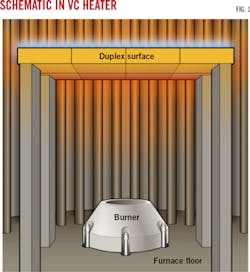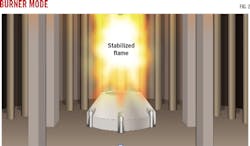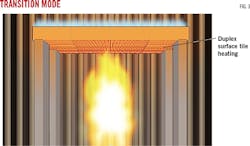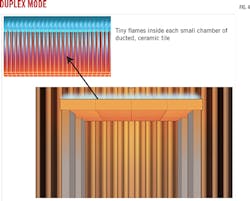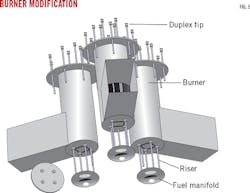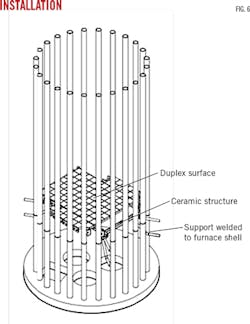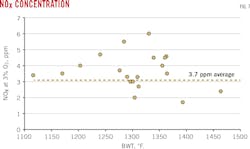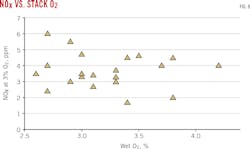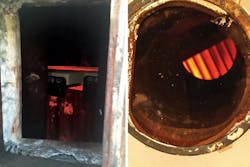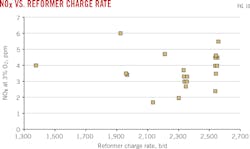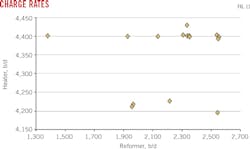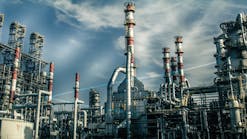Roberto Ruiz
Donald Kendrick
ClearSign Combustion Corp.
Seattle, Wash.
As US federal and state environmental agencies move to further tighten standards established by the 1990 Clean Air Act Amendments on allowable emissions of nitrogen oxide (NOx) from fired-heater and boiler combustion sources, refiners and petrochemical operators remain under pressure to implement technologies that can achieve stricter emission limits without compromising energy efficiency and plant economics.
Existing NOx-reduction technologies such as external flue gas recirculation (EFGR) and selective catalytic reduction (SCR) are well-established systems for hitting emission targets. But these post-combustion approaches entail high capital and operating costs stemming from their more complex upfront designs, equipment requirements, and planned-unplanned maintenance cycles (OGJ, Nov. 2, 1992, p. 45). In an effort to avert issues that can accompany EFGR and SCR systems, a California refiner recently opted to implement Duplex, a front-end, fuel-combustion technology developed by ClearSign Combustion Corp., Seattle, Wash.
Retrofitted into a multiple-burner, vertical-cylindrical (VC) production process heater at the refinery, the technology has proven effective at reducing NOx emissions to levels that meet or exceed California's regional regulatory requirements, some of the most stringent in the US.
Alongside achieving NOx-emission levels below 5 ppm and maintaining stable performance over a wide range of processing conditions, the technology also enabled the refinery to reliably achieve average carbon monoxide (CO)-emission levels well below the region's permissible maximum.
Technology overview
Duplex technology hinges on its central piece of equipment, a porous, ceramic-surface tile installed downstream of existing gas burners in a fired heater or boiler, positioned a few feet away from where fuel and air are introduced into the furnace.
The technology achieves lower emissions vs. traditional burners by integrating several NOx-reduction techniques, including premixed combustion behavior, fuel-air mixture dilution, and radiation cooling.
• Premixed combustion behavior. Diffusion flames in conventional burners generate large amounts of NOx as a result of ignition occurring at the burner throat immediately after fuel and air are introduced into the furnace, before the components have had a change to adequately mix.
While fuel and air enter a furnace outfitted with the new technology in a manner similar to that of conventional burners, the new burner delays ignition until fuel and air-after having an opportunity to thoroughly mix-reach the ceramic surface, where combustion is contained within the porous tile's thousands of small chambers.
Relegating combustion to the pores of the ceramic matrix transforms the single large and turbulent flame of a conventional burner into thousands of shorter, more efficient, and more easily managed flames. This approach provides the inherent NOx-reduction benefits of a premixed system without the disadvantages associated with premixed combustion (e.g., flashback, potential for flame impingement, energy waste).
• Fuel-air mixture dilution. The technology also allows for entrainment of sufficient internal flue gas as the fuel-air jet travels to the ceramic surface to dilute NOx-forming species within the jet. This entrainment and subsequent dilution enables more through mixing of the fuel-air jet and helps reduce peak-flame temperatures. The premixing of air, fuel, and entrained flue gas ahead of ignition at the ceramic surface leads to combustion at lower temperatures and shorter reaction times compared to traditional burners, and allows for better control of thermal NOx.
• Radiation cooling. The majority of the new process's energy transfer takes place as solid-body radiation (gray body), a considerably more effective energy transfer mechanism than the flame radiation used in traditional burners because of the spectrally dependent manner in which gaseous-fuel flames radiate energy. Heat is radiated more efficiently than a raw flame and in a way that prevents flames from impinging on furnace process tubes. This enhanced radiation-heat transfer enables radiative cooling of both the flame and the combustion products, further reducing temperatures and formation of thermal-NOx.1-3
Fig. 1 shows a schematic of the ceramic-tile surface configuration in a VC process heater.
Modes of operation
The new technology has three operating modes.
• Cold-furnace startup and warmup (burner mode). Because system operation requires heating of the ceramic-tile surface, existing burner pilots are ignited using the refinery's standard procedures so that the heater operates in burner mode (e.g., flames stabilized at the burner throat) during the furnace and surface warmup period.
• Transition mode. Verifying the ceramic-tile surface temperature after warmup ensures it exceeds the ignition temperature of the gas. While there is no direct measurement of ignition temperature, it typically correlates to the heater's firebox, or bridgewall, temperature (BWT)-the furnace-gas temperature as measured downstream of the radiant section-or the surface glow of the ceramic-surface tile.
• Duplex-mode. Interrupting fuel supply to the standard burner nozzles and transitioning it to the new nozzles follows verification of ignition temperature and completes the transition to the new operational mode. Burner pilots turn off within seconds of confirming operation and the heater ramps up to its design capacity.
Figs. 2-4 show the three modes of Duplex operation.
Refinery retrofit
Completed in August 2016, the southern California refinery retrofit involved installation of the technology in a VC reformer-splitter reboiler process heater with a maximum firing capacity of 11.25 MMbtu/hr. The heater's radiant section included a 9.65-ft diameter, 17.85-ft high outside shell.
Previously equipped with three natural-draft 3.75-MMbtu/hr ultralow-NOx (ULN) burners installed on the furnace floor, the VC furnace heats fluid it receives from a distillation tower to fractionate process fluid from a reforming unit.
The technology retrofit sought to modify the three-burner VC heater to meet NOx emissions of ≤ 6 ppm, corrected at 3% O2 (≤ 0.007 lb NOx/MMbtu) over a wide range of refinery process conditions without using EFGR or SCR.
Selected refinery fuel gas-composition data collected for the 24-week operating period immediately preceding the project provided the baseline for determining its effectiveness. The fuel gas-composition data consisted of the maximum, minimum, and average hydrogen (H2) content (in vol. % at standard temperature and pressure, STP), methane (CH4) content (in vol. % at STP), and lower heating value (LHV, in btu/scf).
Table 1 shows data collected during the 24-week period.
Despite a series of equipment modifications and additions, the retrofitting project took less than 2 days of furnace downtime to complete, with the VC heater promptly returned to full production for post-retrofit performance testing.
Changes, modifications
To accommodate the technology in existing refinery operations, the retrofit included installation of the following components (Fig. 5):
• Separate new fuel manifolds, risers, and tips at each of the VC heater's three existing ULN burners.
• New valves in each ULN burner's fuel supply lines.
• The ceramic-surface structure and associated supports on the furnace shell.
• Additional valves and instrumentation.
Modifications to the VC heater's ULN burners entailed only simple component additions necessary to ensure burner compatibility with the new components' operation. All existing fuel manifolds, risers, and tips were kept intact.
Each new doughnut-shaped fuel manifold installed at the bottom of ULN burners during the retrofit delivered fuel to the four added risers with the technology's specially designed tips, positioned in the burner throat within the air supply's core.
Installing new valves at the ULN burners' fuel supply lines provided the independent fuel supplies needed to accommodate the technology's various forms of operation.
The existing furnace also required the addition of a ceramic structure to hold the porous surface tile above the burner. The high-temperature structure was installed on new supports that were welded directly to the furnace shell (Fig. 6).
Additions also involved new valving and instrumentation required for proper control and safety monitoring, including both an ultraviolet (UV) scanner to detect flames on the porous surface tile and oxygen-control equipment.
Testing
Data were collected for 6 weeks after commissioning to verify NOx performance under typical process conditions experienced at the refinery.
NOx data collection used Testo Inc.'s 350 portable-emissions analyzer with a low-NOx cell. Flue gas samples were drawn from the furnace stack and conditioned using a sample dryer with a fast loop. Wet-oxygen data was obtained using an in situ zirconium-oxide oxygen probe installed downstream of the convection section.
More than 100 data points were collected during post-retrofit testing.
Results
System implementation met and exceeded the refiner's objective of NOx emissions ≤ 6 ppm, corrected at 3% O2, with actual emissions during the 6-week evaluation averaging 3.7 ppm, corrected at 3% O2 (Figs. 7-8).
While data revealed slight variations in NOx content, emission levels at 2.5-4.5 ppm remained consistently below the project's maximum 6-ppm target. Fluctuations likely resulted from dynamic conditions encountered in refinery operations (rapid changes in thermal loads, fuel-heating values, and other process variables) not specifically monitored as part of the study. Qualitative measurements of the ceramic-surface glow across the evaluation period, however, showed optimal technology performance across all observable process conditions (Fig. 9).
Because thermal load in the reboiler process heater depends on reforming-unit processing conditions, the refiner also requested to monitor operation as a function of the reformer's charge rate. Daily charge rates of the reformer and reboiler were kept at constant values and experienced only minor deviations. (Figs. 10-11).
Alongside reducing NOx-emissions, the retrofit contributed to lower CO emissions. Despite relatively low-BWTs during the testing period, CO emissions averaged 25 ppm, corrected at 3% O2, half the regional regulatory requirement of 50 ppm.
Economic analysis
A confidentiality agreement with the operator prevents disclosure of a cost breakdown for the California refinery's retrofit. Norton Engineering Inc., Montville, NJ, however, conducted an independent review to generate cost estimates for installations of both the new technology and SCR for three operating cases based on two typical refinery process heaters.4
While these reviews considered higher-capacity VC heaters than the 12-MMbtu process heater retrofitted at the California refinery, the study provides a general overview of cost differences between the two technologies under different scenarios.
Configurational details of for each of the three case studies were:
Case 1
• 100-MMbtu/hr fired-duty VC heater, 25-ft diameter.
• Eight existing ULN burners.
• Manual operation of new nozzle and standard burner valves.
Case 2
• 40-MMbtu/hr fired-duty VC heater, 16-ft diameter.
• Four existing ULN burners.
• Manual operation of new nozzle and standard burner valves.
Case 3
• 40-MMbtu/hr fired-duty VC heater, 16-ft diameter.
• Four existing ULN burners.
• Automated operation of new nozzle and standard burner and pilot-gas fuel valves.
The scope of general modifications to the case-study heaters to accommodate modified operation included:
• New supports, support structure for the ceramic surface.
• Ceramic-surface tiles.
• New gas nozzles, risers, and header ring retrofitted to existing burners.
• New gas supply piping and valves.
• New stack educator for pre-lightoff purge of the heater firebox.
• New sealed observation doors to prevent tramp air at burner tile.
• New UV scanners.
• New O2 analyzer.
• Programming for existing heater's safety instrumented system (SIS).
Case 1 also included installation of a stack damp actuator for O2-draft control. In Case 2, however, the analysis accounted for installation of burner-air register actuators for O2 control in lieu of the stack damp actuator used in Case 1.
Case 3 modifications also included adding:
• Automated burner-fuel gas shutoff valves to each burner.
• Automated Duplex gas shutoff valves for each burner.
• Automated pilot gas shutoff valves for each burner.
• Automated spark ignitors for each pilot.
• Flame detection for pilots (fire rod).
To determine costs of implementing SCR in each case, NEC used cost curves for SCR installations previously completed for California's South Coast Air Quality Management District.
Developed based on quotes for SCR equipment, the curves accounted for various-sized combustion sources and included these SCR-related cost considerations:
• Necessary ductwork from heater to SCR reactor.
• SCR reactor and catalyst.
• Ammonia injection grid.
• Ammonia storage, injection, and vaporization equipment.
• Induced draft (ID) fan.
• Support steel.
SCR-cost determinations assumed a moderate installation complexity, as well as a single-heater installation. The analysis did not consider possible cases of SCR's combined-installation in multiple heaters, which can substantially reduce the per-heater cost of installation. The SCR cost estimate also did not account for costs associated with potentially extensive upgrades to electrical infrastructure (e.g., substations, feeders, etc.) that may be necessary to add the ID fan required for SCR implementation.
While a basic installation of the new technology requires no incremental operating costs, SCR entails incremental operating costs that include ammonia and electricity.
Table 2 presents the two technologies' initial installation and incremental operating cost estimates for Cases 1-3.
Both technologies, however, require ongoing operating costs. Analyses of the new technology considered annual maintenance costs for instrumentation-electrical (IE) reliability and SIS, as well as replacement costs for 50% of the tile-support system.
In addition to annual maintenance costs for IE reliability, SIS, and rotating equipment, SCR projections accounted for a one-time complete catalyst replacement and other yearly operating costs for electricity and ammonia supply.
Table 3 shows ongoing-cost projections for the two technologies over a 10-year period.
References
1. Breidenthal, R., Krichtafovitch, I., Karkow, D., and Colannino, J., "Radiative cooling in a flameholder for NOx reduction," 67th Annual Meeting of the American Physical Society Division of Fluid Dynamics, San Francisco, Calif., Nov. 23-25, 2014, http://meetings.aps.org/link/BAPS.2014.DFD.A34.5.
2. Karkow, D., Colannino, J., Dansie, J., Kendrick, D.W., Dumas, J., and Ruiz, R., "Duplex Technology Demonstrates Sub-5 PPM NOx and CO Simultaneously Without SCR, FGR, or High Excess Air," American Flame Research Committee Industrial Combustion Symposium, Salt Lake City, Utah, Sept. 9-11, 2015.
3. Siegel, R., and Howell, J., "Thermal Radiation Heat Transfer," 4th Ed., Taylor & Francis, New York, 2002.
4. Steves, C., Zhang, Z., and Lincoln, D., "Duplex Technology Evaluation and Cost Comparison to SCR," Norton Engineering Inc., Montville, NJ, Jan. 20, 2017.
Based on a presentation to the American Flame Research Committee Industrial Combustion Symposium, Kauai, Ha., Sept. 11-14, 2016.
The authors
Roberto Ruiz ([email protected]) is chief operating officer (COO) for ClearSign Combustion Corp., Seattle, Wash. Prior to joining ClearSign in 2012, he served as president and COO of OnQuest Inc., San Dimas, Calif., and vice-president for process burners at John Zink Co. LLC, Tulsa. Ruiz holds a BS (1979) in engineering from the University of California, Los Angeles, an MS (1981) and PhD (1986) in mechanical engineering from the University of Minnesota, Minneapolis, and an MBA (1997) from the University of Chicago.
Donald Kendrick ([email protected]) is chief technology officer (CTO) for ClearSign Combustion Corp., Seattle, Wash. Before joining ClearSign in 2015, he served as director and CTO of Lean Flame Inc., Washington, DC, and as aerothermal department head at Ramgen Power Systems LLC, Bellevue, Wash., where he developed the first-ever trapped vortex combustor for land-based gas turbine applications. In addition to 12 patents, Kendrick has authored more than 40 publications and papers in the fields of thermal sciences, fluid dynamics, and combustion. He holds a BS (1989) in mechanical engineering from the University of British Columbia, Vancouver, and both an MS (1990) and PhD (1995) in mechanical engineering from California Institute of Technology, Pasadena.
